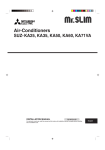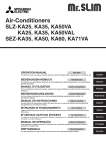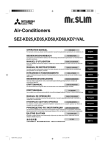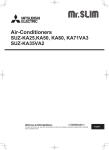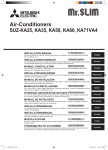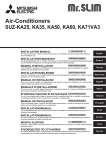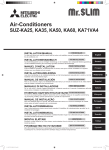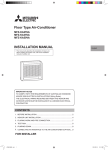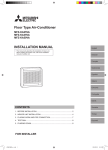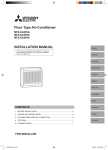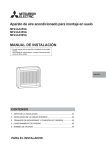Download Mitsubishi Electric KA50 Installation manual
Transcript
Air-Conditioners SEZ-KA35, KA50, KA60, KA71VA INSTALLATION MANUAL FOR INSTALLER For safe and correct use, please read this manual and outdoor unit installation manual thoroughly before installing the air-conditioner unit. English E°XEIPI¢IO O¢H°IøN E°KATA™TA™H™ °È· ÛˆÛÙ‹ Î·È ·ÛÊ·Ï‹ ¯Ú‹ÛË, ‰È·‚¿ÛÙ ÚÔÛÂÎÙÈο ·˘Ùfi ÙÔ ÂÁ¯ÂÈÚ›‰ÈÔ, ηıÒ˜ Î·È ÙÔ ÂÁ¯ÂÈÚ›‰ÈÔ ÂÁηٿÛÙ·Û˘ Ù˘ Â͈ÙÂÚÈ΋˜ ÌÔÓ¿‰·˜, ÚÈÓ ·fi ÙËÓ ÂÁηٿÛÙ·ÛË Ù˘ ÌÔÓ¿‰·˜ ÎÏÈÌ·ÙÈÛÙÈÎÔ‡. POUR L’INSTALLATEUR ∂ÏÏËÓÈο PER L’INSTALLATORE °π∞ ∞À∆√¡ ¶√À ∫∞¡∂π ∆∏¡ ∂°∫∞∆∞™∆∞™∏ Contents 1. 2. 3. 4. 5. Safety precautions ................................................................................... Selecting the installation location ............................................................. Installation diagram & Accessories .......................................................... Indoor unit installation .............................................................................. Refrigerant piping work ............................................................................ 2 2 3 4 4 6. 7. 8. 9. 10. Drainage piping work ............................................................................... 6 Electrical work .......................................................................................... 6 Air filter installation ................................................................................... 9 Duct work ............................................................................................... 11 Test run .................................................................................................. 11 1. Safety precautions • • • • Please report to or take consent by the supply authority before connection to the system. Be sure to read “Safety precautions” before installing the air conditioner. Be sure to observe the cautions specified here as they include important items related to safety. The indications and meanings are as follows. Warning: Could lead to death, serious injury, etc. Warning: • Do not install it by yourself (customer). Incomplete installation could cause injury due to fire, electric shock, the unit falling or leakage of water. Consult the dealer from whom you purchased the unit or special installer. • Install the unit securely in a place which can bear the weight of the unit. When installed in an insufficient strong place, the unit could fall causing injured. • Use the specified wires to connect the indoor and outdoor units securely and attach the wires firmly to the terminal board connecting sections so the stress of the wires is not applied to the sections. Incomplete connecting and fixing could cause fire. • Do not use intermediate connection of the power cord or the extension cord and do not connect many devices to one AC outlet. It could cause a fire or an electric shock due to defective contact, defective insulation, exceeding the permissible current, etc. • Check that the refrigerant gas does not leak after installation has completed. Caution: • Perform grounding. Do not connect the ground wire to a gas pipe, water pipe arrester or telephone ground wire. Defective grounding could cause an electric shock. • Do not install the unit in a place where an inflammable gas leaks. If gas leaks and accumulates in the area surrounding the unit, it could cause an explosion. • Install a ground leakage breaker depending on the installation place (where it is humid). If a ground leakage breaker is not installed, it could cause an electric shock. Caution: Could lead to serious injury in particular environments when operated incorrectly. • After reading this manual, be sure to keep it together with the instruction manual in a handy place on the customer’s site. : Indicates a part which must be grounded. Warning: Carefully read the labels affixed to the main unit. • Perform the installation securely referring to the installation manual. Incomplete installation could cause a personal injury due to fire, electric shock, the unit falling or leakage of water. • Perform electrical work according to the installation manual and be sure to use an exclusive circuit. If the capacity of the power circuit is insufficient or there is incomplete electrical work, it could result in a fire or an electric shock. • Attach the electrical part cover to the indoor unit and the service panel to the outdoor unit securely. If the electrical part cover in the indoor unit and/or the service panel in the outdoor unit are not attached securely, it could result in a fire or an electric shock due to dust, water, etc. • Be sure to use the part provided or specified parts for the installation work. The use of defective parts could cause an injury or leakage of water due to a fire, an electric shock, the unit falling, etc. • Ventilate the room if refrigerant leaks during operation. If the refrigerant comes in contact with a flame, poisonous gases will be released. • Perform the drainage/piping work securely according to the installation manual. If there is a defect in the drainage/piping work, water could drop from the unit and household goods could be wet and damaged. • Fasten a flare nut with a torque wrench as specified in this manual. When fastened too tight, a flare nut may broken after a long period and cause a leakage of refrigerant. 2. Selecting the installation location 2.1. Indoor unit • • • • Where airflow is not blocked. Where cool air spreads over the entire room. Where it is not exposed to direct sunshine. At a distance 1 m or more away from your TV and radio (to prevent picture from being distorted or noise from being generated). • In a place as far away as possible from fluorescent and incandescent lights (so the infrared remote control can operate the air conditioner normally). 2 • Where the air filter can be removed and replaced easily. Warning: Mount the indoor unit into a ceiling strong enough to withstand the weight of the unit. 3. Installation diagram & Accessories A ■ SEZ-KA35/KA50/KA60/KA71VA Air inlet (rear side) dimensions 42 930 J H 215 240 12.5 120 (mm) Air inlet (bottom side) dimensions G J 7×100=700 955 24-ø2.9 holes 450 150 2 77 39 77.5 100 215 7×100=700 955 J 24-ø2.9 holes 600 50 150 1 930 J 25 51 240 120 1016 I 12.5 29 5027 25 PLATE (A) 77.5 100 700 350 1000 680 5 3 38 60 (10) 50 6 40 50 100 7×100=700 880 9×2-ø2.9 holes 9 0 1070 3 20 or more B 32.5 F 5 D 20 25 94 60 2×2-ø2.9 holes 7 A C 100 75 170 1100 A 2 270 30 25 (10) 50 108 (1070) 3 8 350 E 2 Fig. 3-1 3.1. Indoor unit (Fig. 3-1) 1 2 3 5 6 7 8 9 0 A Air inlet (rear side) *Select the either back side or bottom side Electrical parts box Suspension bolt pitch Access door Service space (It is necessary to maintain a working service area from the ceiling.) Air inlet (bottom side) *Select the either back side or bottom side Suspension bolt M10 or 3/8 (procure locally) Air outlet duct flange Air outlet Refrigerant pipe (gas) B C D E F G H I J Refrigerant pipe (liquid) Wiring entry Terminal block Drain plug R1 Air outlet duct flange In case of bottom side suction, mount the PLATE (A) on the rear side. After installation, remove the transportation support PLATE (B). PLATE (B) × 2 Inlet size A B 3.2. Checking the indoor unit accessories (Fig. 3-2) 1 3 Check that the indoor unit is equipped with the following parts and accessories: A Refrigerant pipe parts 1 Pipe cover (for refrigerant piping joint) Small diameter × 1 Large diameter × 1 2 Bands for temporary tightening of pipe cover × 4 2 B Remote controller parts 3 Parts contained in the cardboard box × 1 Check the contents and read the explanations provided. C 4 C Air filter parts 4 Parts contained in the bag × 1 Check the contents and read the explanations provided. Refrigerant and drainage pipe sizes Model SEZ-KA35VA SEZ-KA50VA SEZ-KA60VA SEZ-KA71VA Refrigerant Liquid OD ø6.35 (1/4") OD ø6.35 (1/4") OD ø6.35 (1/4") pipe Gas Drainage pipe OD ø9.52(3/8") OD ø12.7 (1/2") OD ø9.52 (3/8") OD ø15.88 (5/8") OD ø15.88 (5/8") Hard PVC pipe : OD ø26 (1") Fig. 3-2 3 4. Indoor unit installation 4.1. Suspension Structure (Give site of suspension strong structure.) 35 0 4.1.1. Wooden structure (Fig. 4-1) • Select tie beam (one-story houses) or second-floor girder (two-story houses) as reinforcement member. • Use sturdy beams of at least 6 cm square for beam pitch of 90 cm or less or of at least 9 cm square for beam pitch of 90-180 cm. 70 10 A B A B C D C D Fig. 4-1 Ceiling Rafter Beam Roof beam 4.1.2. Ferroconcrete structures (Fig. 4-2) Secure the suspension bolts using the method shown, or use steel or wooden hangers, etc. to install the suspension bolts. G E Use inserts rated at 100-150 kg each (procure locally) F Suspension bolts M10 (3/8") (procure locally) G Steel reinforcing rod 4.1.3. Installing the suspension bolts E • Check the pitch of the suspension bolts. • Use the ø10 (3/8") suspension bolts (×4, procure locally). • Adhere strictly to the length of the suspension bolts. F Fig. 4-2 c a 4.2. Suspending the unit (Fig. 4-3) e Direct suspension method: Raise the unit and line it up with the suspension bolts, then secure it using both nuts. b d a b c d e Air outlet Air intake (selecting the either back side or bottom side.) Washer (procure locally) Nuts (procure locally) Suspension bolts (procure locally) b Fig. 4-3 4.3. Transportation support removal (Fig. 4-4) After installation, completely remove the transportation support because this part should only be used during transportation. A 3 screws B Transportation support A B A Fig. 4-4 5. Refrigerant piping work 1 SEZ-KA35:ø6.35 SEZ-KA50:ø6.35 SEZ-KA60:ø6.35 SEZ-KA71:ø9.52 5.1. Refrigerant pipe (Fig. 5-1) Piping preparation 2 SEZ-KA35:ø9.52 SEZ-KA50:ø12.7 SEZ-KA60:ø15.88 SEZ-KA71:ø15.88 • Refrigerant pipes of 3, 5, 7, 10 and 15 m are available as optional items. (1) Table below shows the specifications of pipes commercially available. 1 Indoor unit 2 Outdoor unit Fig. 5-1 Model Pipe SEZKA35VA For liquid For gas For liquid For gas For liquid For gas For liquid For gas SEZKA50VA SEZKA60VA SEZKA71VA Outside diameter mm inch 6.35 9.52 6.35 12.7 6.35 15.88 9.52 15.88 1/4 3/8 1/4 1/2 1/4 5/8 3/8 5/8 Min. wall thickness Insulation thickness Insulation material 0.8 mm 0.8 mm 0.8 mm 0.8 mm 0.8 mm 1.0 mm 0.8 mm 1.0 mm 8 mm 8 mm 8 mm 8 mm 8 mm 8 mm 8 mm 8 mm Heat resisting foam plastic 0.045 specific gravity (2) Ensure that the 2 refrigerant pipes are well insulated to prevent condensation. (3) Refrigerant pipe bending radius must be 10 cm or more. Caution: Using careful insulation of specified thickness. Excessive thickness prevents storage behind the indoor unit and smaller thickness causes dew drippage. 4 5. Refrigerant piping work b a c d 90° e a b c d e f f Copper tubes Good No good Tilted Uneven Burred Fig. 5-2 • Main cause of gas leakage is defect in flaring work. Carry out correct flaring work in the following procedure. 5.2.1. Pipe cutting (Fig. 5-2) • Using a pipe cutter cut the copper tube correctly. 5.2.2. Burrs removal (Fig. 5-3) b a 5.2. Flaring work a b c d c d Burr Copper tube/pipe Spare reamer Pipe cutter • Completely remove all burrs from the cut cross section of pipe/tube. • Put the end of the copper tube/pipe to downward direction as you remove burrs in order to avoid burrs drop in the tubing. Fig. 5-3 5.2.3. Putting nut on (Fig. 5-4) a a Flare nut b Copper tube • Remove flare nuts attached to indoor and outdoor unit, then put them on pipe/tube having completed burr removal. (not possible to put them on after flaring work) b Fig. 5-4 a A a b c d e e b d b c c Flaring tool Die Copper tube Flare nut Yoke 5.2.4. Flaring work (Fig. 5-5) • Carry out flaring work using flaring tool as shown at the right. Pipe diameter (mm) Fig. 5-5 6.35 9.52 12.7 15.88 Dimension A (mm) When the tool for R410A is used Clutch type 0 - 0.5 0 - 0.5 0 - 0.5 0 - 0.5 +0 B -0.4 (mm) 9.1 13.2 16.6 19.7 Firmly hold copper tube in a die in the dimension shown in the table at above. a B 5.2.5. Check (Fig. 5-6) b d e f g • Compare the flared work with a figure in right side hand. • If flare is noted to be defective, cut off the flared section and do flaring work again. h a b c d e c i Fig. 5-6 Smooth all around Inside is shining without any scratches Even length all around Too much Tilted f g h i Scratch on flared plane Cracked Uneven Bad examples 5.3. Pipe connection (Fig.5-7) • Apply a thin coat of refrigeration oil on the seat surface of pipe. • For connection first align the center, then tighten the first 3 to 4 turns of flare nut. • Use tightening torque table below as a guideline for indoor unit side union joint section, and tighten using two wrenches. Excessive tightening damages the flare section. Copper pipe O.D. (mm) ø6.35 ø9.52 ø12.7 ø15.88 Fig. 5-7 g f c b h a d e c i c e a b c d e b f g h i Indoor unit (main unit) 1 Pipe cover 2 Band Flare joint Refrigerant pipe and insulating material (must be supplied locally) Position the pipe cover so that the end is in firm contact with the main unit. Fasten it so that there is no clearance. Allow no clearance Separator sheet Cut off the remainder band Flare nut O.D. (mm) 17 22 26 29 Tightening torque (N·m) 14 - 18 34 - 42 49 - 61 68 - 82 Warning: Be careful of flying flare nut! (Internally pressurized) Remove the flare nut as follows: 1. Loosen the nut until you hear a hissing noise. 2. Do not remove the nut until the gas has been completely released (i.e., hissing noise stops). 3. Check that the gas has been completely released, and then remove the nut. Outdoor unit connection Connect pipes to stop valve pipe joint of the outdoor unit in the same manner applied for indoor unit. • For tightening use a torque wrench or spanner, and use the same tightening torque applied for indoor unit. Refrigerant pipe insulation (Fig. 5-8) (1) Peel the separator sheet off the accompanying pipe cover, and wrap it around the refrigerant pipe, making sure that the side which is slit faces upwards. (2) Be sure to fix both ends of the pipe cover using an attachment band (ensure that the band’s joint faces upwards). (3) Stick vinyl tape on the joint positions. Fig. 5-8 5 6. Drainage piping work 6.1. Drainage pipe connection (Fig. 6-1) Indoor unit’s drainage pipe H2 H1 • The drainage pipe should be arranged so that the discharge end is lower than the other end, as shown in the figure opposite. • Place the trap outside the unit. • After connecting the drainage pipe, make sure that water is discharged properly and that there are no leaks. A A Drainage piping connection 1 RP male. B Trap Outdoor unit drainage pipe connection B When drainage piping is necessary, use the drain pan (supplied as an option). H1 : 50 mm or more H2 : 1/2 H1 or more Fig. 6-1 7. Electrical work 7.1. Precautions (Fig. 7-1) (1) SEZ-KA35, KA50, KA60, KA71VA Electrical specification Power supply (1 phase ~/N, 230V, 50Hz) A S1 S2 S3 Input capacity Main Switch/Fuse (A) SEZ-KA35 SEZ-KA50 SEZ-KA60 SEZ-KA71 10 20 20 20 12 • The compressor will not operate unless the power supply phase connection is correct. • Grounding protection with a no-fuse breaker (earth leakage breaker [ELB]) is usually installed for D. • The connection wiring between the outdoor and indoor units can be extended up to a maximum of 50 meters, and the total extension including the crossover wiring between rooms is a maximum of 80 m. B S1 S2 S3 C A B C D E D A switch with at least 3.5 mm contact separation in each pole shall be provided by the air conditioner installation. * Label each breaker according to purpose (heater, unit etc.). Indoor unit Outdoor unit Wired remote controller Main switch/fuse Grounding For Power supply D For Power supply A B E A C Fig. 7-1 6 A 7. Electrical work 1 4 5 7.2. Indoor wire connection (Fig. 7-2) Work procedure 1.Remove 2 screws to detach the electric component cover. 2.Route each cable through the wiring intake into the electric component box. (Procure power cable and in-out connecting cable locally and use remote control cable supplied with the unit.) 3.Securely connect the power cable and the in-out connecting cable and the remote control cable to the terminal blocks. 4.Secure the cables with clamps inside the electric component box. 5.Attach the electric component cover as it was. • Fix power supply cable and indoor/outdoor cable to control box by using buffer bushing for tensile force. (PG connection or the like.) 2 Warning: • Attach the electrical part cover securely. If it is attached incorrectly, it could result in a fire, electric shock due to dust, water, etc. • Use the specified indoor/outdoor unit connecting wire to connect the indoor and outdoor units and fix the wire to the terminal bed securely so that no stress is applied to the connecting section of the terminal bed. Incomplete connection or fixing of the wire could result in a fire. 0 4 • The wiring configuration of the indoor unit’s fan motor is for a 50 Hz power supply. The wiring must be reconfigured if a 60 Hz power supply is used. Refer to the wiring diagram for details. 3 6 9 7 8 5 1 2 3 4 5 6 7 8 9 0 Entry for wired remote controller cable Entry for Indoor-Outdoor connecting cable Cable clamp Remote controller terminal Indoor/Outdoor unit connecting terminal To wired remote controller To outdoor unit Indoor controller Power board Earth cable Fig. 7-2 Indoor terminal block 1 2 2 Earth wire (green/yellow) 4 5 1 Indoor/outdoor unit connecting wire 3-core 1.5 mm2 or more 6 3 L N Outdoor terminal block 7 Power supply cord Fig. 7-3 • Perform wiring as shown in the diagram to the lower left. (Procure the cable locally). (Fig. 7-3) Make sure to use cables of the correct polarity only. 1 Connecting cable Cable 3-core 1.5 mm2, in conformity with Design 245 IEC 57. 2 Indoor terminal block 3 Outdoor terminal block 4 Always install an earth wire (1-core 1.5 mm2) longer than other cables 5 Remote controller cable (non-polar) Cable 2-core 0.3 mm2 The 10 m wire is attached in the remote controller accessory. Max. 500 m 6 Wired remote controller 7 Power supply cord Caution: • Use care not to make miswiring. • Firmly tighten the terminal screws to prevent them from loosening. • After tightening, pull the wires lightly to confirm that they do not move. 7 7. Electrical work B 7.3. Remote controller A 7.3.1. For wired remote controller 30 1) Installing procedures (1) Select an installing position for the remote controller. (Fig. 7-4) The temperature sensors are located on both remote controller and indoor unit. s Procure the following parts locally: Two piece switch box Thin copper conduit tube Lock nuts and bushings 30 30 83.5 46 C A E F I G H 120 C D Fig. 7-4 B-1. B-2. B H H I J I A Remote controller profile B Required clearances surrounding the remote controller C Installation pitch (2) Seal the service entrance for the remote controller cord with putty to prevent possible invasion of dew drops, water, cockroaches or worms. (Fig. 7-5) A For installation in the switch box: B For direct installation on the wall select one of the following: • Prepare a hole through the wall to pass the remote controller cord (in order to run the remote controller cord from the back), then seal the hole with putty. • Run the remote controller cord through the cutout in the upper case, then seal the cutout notch with putty similarly as above. B-1. To lead the remote controller cord from the back of the controller: B-2. To run the remote controller cord through the upper portion: (3) For direct installation on the wall C D E F Fig. 7-5 G H I J Wall Conduit Lock nut Bushing Switch box Remote controller cord Seal with putty Wood screw 2) Connecting procedures (Fig. 7-6) 1 Connect the remote controller cord to the terminal block. A A To the terminal block on the indoor unit B TB6 (No polarity) 2 Set the dip switch No.1 shown below when using two remote controller’s for the same group. C Dip switches B 3) Function selection of remote controller If two remote controllers are connected, set one to “Main” and the other to “Sub”. For setting procedures, refer to “Function selection of remote controller” in the operation manual for the indoor unit. Fig. 7-6 7.4. Function settings AB TB6 7.4.1 Function setting on the unit (Selecting the unit functions) 2 3 4 1 ⁄ 2 ⁄ 3 ⁄ 4 ⁄ 1 TEMP. F E G MENU BACK PAR-21MAA MONITOR/SET ON/OFF ON/OFF FILTER DAY CLOCK A Mode number Setting number Refrigerant address Unit number 1) AUTO RESTART FUNCTION Indoor controller board This model is equipped with the AUTO RESTART FUNCTION. (the DIP switch on the indoor controller board) When the indoor unit is controlled with the remote controller, the operation mode, set temperature, and the fan speed are memorized by the indoor controller board. The auto restart function sets to work the moment the power has restored after power failure, then, the unit will restart automatically. SW3 CHECK TEST OPERATION CLEAR B 1 2 3 4 C D 5 ON OFF Power failure automatic recovery 4 OFF : Not available ON : Available (Initial setting) * When the power supply returns, the air conditioner will start 3 minutes later. 1 1 Fig. 7-7 8 2 2) Other functions For wired remote controller only (Fig. 7-7) Changing the power voltage setting • Be sure to change the power voltage setting depending on the voltage used. 1 Go to the function setting mode. Switch OFF the remote controller. Press the A and B buttons simultaneously and hold them for at least 2 seconds. FUNCTION will start to flash. 2 Use the C button to set the refrigerant address (3) to 00. 3 Press D and [--] will start to flash in the unit number (4) display. 4 Use the C button to set the unit number (4) to 00. 5 Press the E MODE button to designate the refrigerant address/unit number. [--] will flash in the mode number (1) display momentarily. 6 Press the F buttons to set the mode number (1) to 04. 7 Press the G button and the current set setting number (2) will flash. Use the F button to switch the setting number in response to the power supply voltage to be used. Power supply voltage 240 V : setting number = 1 220 V, 230 V : setting number = 2 8 Press the MODE button E and mode and the setting number (1) and (2) will change to being on constantly and the contents of the setting can be confirmed. 9 Press the FILTER A and TEST RUN B buttons simultaneously for at least two seconds. The function selection screen will disappear momentarily and the air conditioner OFF display will appear. 7. Electrical work Function table Select unit number 00 Mode Power failure automatic recovery*1 (AUTO RESTART FUNCTION) Indoor temperature detecting Settings Not available Available Indoor unit operating average Set by indoor unit’s remote controller Remote controller’s internal sensor Not Supported Supported (indoor unit is not equipped with outdoor-air intake) Supported (indoor unit is equipped with outdoor-air intake) 240 V 220 V, 230 V Energy saving cycle automatically enabled Energy saving cycle automatically disabled LOSSNAY connectivity Power voltage Auto mode (only for PUHZ) Select unit numbers 01 to 03 or all units (AL [wired remote controller]/07 [wireless remote controller]) Mode Settings Filter sign 100 Hr 2500 Hr No filter sign indicator Fan speed Standard (PLH/PLA)/Silent (PCH/PCA) High ceiling 1 (PLH/PLA)/Standard (PCH/PCA) High ceiling 2 (PLH/PLA)/High ceiling (PCH/PCA) No. of air outlets 4 directions 3 directions 2 directions Installed options (high-performance filter) Not supported Supported Up/down vane setting No vanes Equipped with vanes (vanes angle setup 1) Equipped with vanes (vanes angle setup 2) Energy saving air flow Disabled (Heating mode) Enabled Mode no. 01 02 03 04 05 Mode no. 07 08 09 10 11 12 Setting no. Initial setting 1 *1 2 *1 1 2 3 1 2 3 1 2 1 2 Setting Setting no. Initial setting 1 2 3 1 2 – 3 1 2 – 3 1 – 2 – 1 2 – 3 1 – 2 – Setting *1 For this model, mode no. 1 cannot be set using the remote controller. Set this mode using DIP switch SW3-1 of the indoor controller board. 8. Air filter installation 1 8.1. Confirmation of enclosed parts (Fig. 8-1) 2 • Please ensure all the parts shown below are present before starting installation. Cut out 3 4 5 1 2 3 4 5 6 Filter × 1 Filter rail × 1 Filter rail × 1 ST. screw (4 × 10) × 14 Clamp × 2 Seal × 2 Hole Cut out 6 Fig. 8-1 8.2. Filter rail installation (Rear air intake) (Fig. 8-2) 2 A 1 B 3 ■ Please select air intake direction A or B 1. Transportation support remove (Throw away). 2. Please attach filter rail 2 as per the diagram (screw × 6). Please connect rails 2 3 carefully. 3. Please attach filter rail 3 as per the diagram (screw × 6). Please connect rails 2 3 carefully. 4. Seal 6 Upright position here. A Control box B Drain pan C Air tight seal Level with edge A C 4 C Fig. 8-2 9 8. Air filter installation A 8.3. Filter rail installation (Bottom air intake) (Fig. 8-3) 2 1. Transportation support remove (Throw away). 2. Please move the plate position. (Please use the screws removed.) 3. Please attach filter rail 2 as per the diagram (screw × 6). Please connect rails 2 3 carefully. 4. Please attach filter rail 3 as per the diagram (screw × 6). Please connect rails 2 3 carefully. 5. Clamp 5 (Attach the clamps 5 with screw × 2) Upright position here. 6. Seal 6 Upright position here. 1 4 A Control box C Air tight seal Level with edge 5 4 5 A 3 C C 6 Fig. 8-3 A 8.4. Filter installation points (Rear air intake) (Fig. 8-4) E 1. Insert the filter into rail 2 2. Hook the filter onto rail 3 1 D A B D E F Control box Drain pan Filter Rail 2 Rail 3 2 B F Fig. 8-4 8.5. Filter installation points (Bottom air intake) (Fig. 8-5) A 1. Insert the filter into rail 2 2. Hook the filter onto rail 3 3. Bend the clamp to hold the filter. A D E F G H 1 2 F E D H A G F E Fig. 8-5 10 Control box Filter 1 Rail 2 Rail 3 Bend Clamp 5 9. Duct work In case of rear-side suction B C A N D O Use the canvas duct for connecting the indoor unit and the duct. (Fig. 9-1) Use fireproof material for the duct parts. Make sure that the duct has sufficient heat insulation. E M K P H I L J F G In case of bottom-side suction E Q Fig. 9-1 A B C D E F G H I J K L M N O P Q Electrical parts box Canvas duct Air outlet flange Air outlet duct Filter (Accessory) Air outlet grille Air intake grille Ceiling Drainage pan Air intake Air outlet Allow clearance to avoid short cycling. Indoor unit Earth terminal Earth cable 850 mm or more Safety net (procured locally) Notes: • The fan and motor are dangerous if handled during operation. For this reason, be sure to install the indoor unit at least 850 mm from the air intake grill G. If it is not possible to put more than 850 mm of distance between the air intake grill and the indoor unit, install the safety net Q (locally procured). • Connect the main body of the air conditioner and the duct so that their potentials are equal. • Connect an earth cable O from the air outlet flange C to the earth terminal N. Then, connect another earth cable O from the earth terminal N to the air outlet duct D. • Be sure to install an air filter (procure locally) and an air outlet duct. 10.Test run 10.1. Before test run s After completing installation and the wiring and piping of the indoor and outdoor units, check for refrigerant leakage, looseness in the power supply or control wiring, wrong polarity, and no disconnection of one phase in the supply. s Use a 500-volt megohmmeter to check that the resistance between the power supply terminals and ground is at least 1.0 MΩ. s Do not carry out this test on the control wiring (low voltage circuit) terminals. Warning: Do not use the air conditioner if the insulation resistance is less than 1.0 MΩ. Insulation resistance After installation or after the power source to the unit has been cut for an extended period, the insulation resistance will drop below 1 MΩ due to refrigerant accumulating in the compressor. This is not a malfunction. Perform the following procedures. 1. Remove the wires from the compressor and measure the insulation resistance of the compressor. 2. If the insulation resistance is below 1 MΩ, the compressor is faulty or the resistance dropped due the accumulation of refrigerant in the compressor. 3. After connecting the wires to the compressor, the compressor will start to warm up after power is supplied. After supplying power for the times indicated below, measure the insulation resistance again. • The insulation resistance drops due to accumulation of refrigerant in the compressor. The resistance will rise above 1 MΩ after the compressor is warmed up for two to three hours. (The time necessary to warm up the compressor varies according to atmospheric conditions and refrigerant accumulation.) • To operate the compressor with refrigerant accumulated in the compressor, the compressor must be warmed up at least 12 hours to prevent breakdown. 4. If the insulation resistance rises above 1 MΩ, the compressor is not faulty. Caution: • The compressor will not operate unless the power supply phase connection is correct. • Turn on the power at least 12 hours before starting operation. - Starting operation immediately after turning on the main power switch can result in severe damage to internal parts. Keep the power switch turned on during the operational season. 11 10.Test run F E C D B TEST RUN COOL, HEAT ˚C ˚C SIMPLE TEMP. ON/OFF MENU BACK ON/OFF PAR-21MAA A FILTER DAY MONITOR/SET CHECK TEST OPERATION CLOCK HG CLEAR A ON/OFF button B Test run display C Indoor temperature liquid line temperature display D ON/OFF lamp E Power display F Error code display Test run remaining time display G Set temperature button H Mode selection button I Fan speed button M TEST button 10.2. Test run The following 3 methods are available. 10.2.1. Using wired remote controller (Fig. 10-1) 1 2 3 4 5 6 7 8 I M Fig. 10-1 B 10.3. Self-check E D 10.3.1. Wired remote controller (Fig. 10-2) ERROR CODE B E ERROR CODE TEMP. Turn on the power at least 12 hours before the test run. Press the [TEST] button twice. ➡ “TEST RUN” liquid crystal display Press the [Mode selection] button. ➡ Make sure that wind is blown out. Press the [Mode selection] button and switch to the cooling (or heating) mode. ➡ Make sure that cold (or warm) wind is blown out. Press the [Fan speed] button. ➡ Make sure that the wind speed is switched. Check operation of the outdoor unit fan. Release test run by pressing the [ON/OFF] button. ➡ Stop Register a telephone number. The telephone number of the repair shop, sales office, etc., to contact if an error occurs can be registered in the remote controller. The telephone number will be displayed when an error occurs. For registration procedures, refer to the operation manual for the indoor unit. ON/OFF 1 2 3 4 Turn on the power. Press the [CHECK] button twice. Set refrigerant address with [TEMP] button if system control is used. Press the [ON/OFF] button to stop the self-check. ERROR CODE C MENU BACK MONITOR/SET PAR-21MAA ON/OFF FILTER DAY CLOCK CHECK TEST OPERATION F CLEAR A B C D CHECK button Refrigerant address TEMP. button IC: Indoor unit OC: Outdoor unit E Check code F Unit address A Fig. 10-2 • For description of each check code, refer to the following table. Check code P1 P2 P9 E6, E7 P4 P5 PA P6 EE P8 E4, E5 Fb E0, E3 E1, E2 E9 UP U3, U4 UF U2 U1, Ud U5 U8 U6 U7 U9, UH Others Symptom Intake sensor error Pipe (TH2) sensor error Pipe (TH5) sensor error Indoor/outdoor unit communication error Drain sensor error Drain pump error Forced compressor error Freezing/Overheating safeguard operation Communication error between indoor and outdoor units Pipe temperature error Remote controller signal receiving error Indoor unit control system error (memory error, etc.) Remote controller transmission error Remote controller control board error Indoor/outdoor unit communication error (Transmitting error) (Outdoor unit) Compressor overcurrent interruption Open/short of outdoor unit thermistors Compressor overcurrent interruption (When compressor locked) Abnormal high discharging temperature/49C worked/insufficient refrigerant Abnormal high pressure (63H worked)/Overheating safeguard operation Abnormal temperature of heat sink Outdoor unit fan safeguard stop Compressor overcurrent interruption/Abnormal of power module Abnormality of super heat due to low discharge temperature Abnormality such as overvoltage or voltage shortage and abnormal synchronous signal to main circuit/ Current sensor error Other errors (Refer to the technical manual for the outdoor unit.) Remark For details, check the LED display of the outdoor controller board. *1 If the beeper does not sound again after the initial two beeps to confirm the self-check start signal was received and the OPERATION INDICATOR lamp does not come on, there are no error records. *2 If the beeper sounds three times continuously “beep, beep, beep (0.4 + 0.4 + 0.4 sec.)” after the initial two beeps to confirm the self-check start signal was received, the specified refrigerant address is incorrect. Check code displayed in the LCD. 12 This product is designed and intended for use in the residential, commercial and light-industrial environment. The product at hand is based on the following EU regulations: • • Low Voltage Directive 73/23/ EEC Electromagnetic Compatibility Directive 89/ 336/ EEC Please be sure to put the contact address/telephone number on this manual before handing it to the customer. HEAD OFFICE: MITSUBISHI DENKI BLDG., 2-2-3, MARUNOUCHI, CHIYODA-KU, TOKYO 100-8310, JAPAN BG79U787H01 Printed in Thailand













